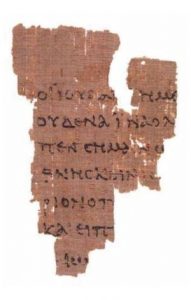In my previous post I addressed the question of the famous P52 manuscript. But the article by Pasquale Orsini and Willy Clarysse is more generally a critique of “theological palaeography” and I highlight here some of their other more points about the principles involved with the dating of manuscripts.
The page references are from Pasquale Orsini & Willy Clarysse, “Early New Testament Manuscripts and Their Dates: A Critique of Theological Palaeography,” Ephemerides Theologicae Lovanienses 88 (2012): 443-74. (In the extracts I am responsible for all bolding of text and formatting that goes beyond normal paragraphing.)
1. The Problem of Dating Literary Papyri
Only a few literary papyri can be dated thanks to
- circumstantial evidence — i.e. their archaeological or historical context
- or when they belong to a dated archive
- or when they are written on the back or front of documentary text (this can give a terminus post — if written on the back; or an ante quem — if a dated document is written on their verso/back)
Other manuscripts (the majority) are thus dated by comparing their handwriting to datable scripts. This gives a relative, not absolute, date for most.
2. New Testament Texts and their Dates
New Testament manuscripts are more problematic than other literary texts since they are nearly always written as part of a codex. This means that the script is the same on both sides of each page and neither side can be used to establish a terminus ante or post quem.
Gradually, however, an uneasy consensus has been reached among papyrologists, and the result of this is found in the dates put forward by Nestle-Aland.
| NESTLE–ALAND, 1994 = K. ALAND, Kurzgefasste Liste der griechischen Hand-schriften des Neuen Testaments. Zweite, neugearbeitete und ergänzte Auflage, bearbeitet von K. ALAND, in Verbindung mit M. WELTE, B. KÖSTER und K. JUNACK (Arbeiten zur Neutestamentlichen Textforschung 1), Berlin – New York, 1994;
see updates in: http://intf.uni-muenster.de/vmr/NTVMR/ListeHandschriften.php |
As I cited in my previous post, no NT manuscripts are dated to the first century and “only very few to the second century.”
Recently even these early dates have been called into question by R.S. Bagnall [see R.S. BAGNALL, Early Christian Books in Egypt, Princeton, NJ – Oxford, 2009, pp. 11-18.]
Stepping outside of the Orsini-Clarysse article for a moment, here are three online reviews of Bagnall’s book: Continue reading “More On Dating New Testament Manuscripts (and the Rylands Fragment P52 again)”
Like this:
Like Loading...



